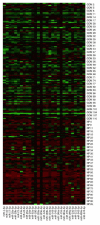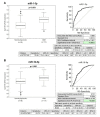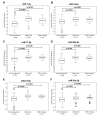Diabetes Mellitus and Cardiovascular Risk Assessment in Mothers with a History of Gestational Diabetes Mellitus Based on Postpartal Expression Profile of MicroRNAs Associated with Diabetes Mellitus and Cardiovascular and Cerebrovascular Diseases
- PMID: 32244558
- PMCID: PMC7177375
- DOI: 10.3390/ijms21072437
Diabetes Mellitus and Cardiovascular Risk Assessment in Mothers with a History of Gestational Diabetes Mellitus Based on Postpartal Expression Profile of MicroRNAs Associated with Diabetes Mellitus and Cardiovascular and Cerebrovascular Diseases
Abstract
Mothers with a history of gestational diabetes mellitus (GDM) have an increased risk of developing diabetes in the future and a lifelong cardiovascular risk. Postpartal expression profile of cardiovascular/cerebrovascular disease associated microRNAs was assessed 3-11 years after the delivery in whole peripheral blood of young and middle-aged mothers with a prior exposure to GDM with the aim to identify a high-risk group of mothers at risk of later development of diabetes mellitus and cardiovascular/cerebrovascular diseases who would benefit from implementation of early primary prevention strategies and long-term follow-up. The hypothesis of the assessment of cardiovascular risk in women was based on the knowledge that a series of microRNAs play a role in the pathogenesis of diabetes mellitus and cardiovascular/cerebrovascular diseases. Abnormal expression profile of multiple microRNAs was found in women with a prior exposure to GDM (miR-1-3p, miR-16-5p, miR-17-5p, miR-20a-5p, miR-20b-5p, miR-21-5p, miR-23a-3p, miR-24-3p, miR-26a-5p, miR-29a-3p, miR-100-5p, miR-103a-3p, miR-125b-5p, miR-126-3p, miR-130b-3p, miR-133a-3p, miR-143-3p, miR-145-5p, miR-146a-5p, miR-181a-5p, miR-195-5p, miR-199a-5p, miR-221-3p, miR-342-3p, miR-499a-5p, and-miR-574-3p). Postpartal combined screening of miR-1-3p, miR-16-5p, miR-17-5p, miR-20b-5p, miR-21-5p, miR-23a-3p, miR-26a-5p, miR-29a-3p, miR-103a-3p, miR-133a-3p, miR-146a-5p, miR-181a-5p, miR-195-5p, miR-199a-5p, miR-221-3p, and miR-499a-5p showed the highest accuracy for the identification of mothers with a prior exposure to GDM at a higher risk of later development of cardiovascular/cerebrovascular diseases (AUC 0.900, p 0.001, sensitivity 77.48%, specificity 93.26%, cut off >0.611270413). It was able to identify 77.48% mothers with an increased cardiovascular risk at 10.0% FPR. Any of changes in epigenome (upregulation of miR-16-5p, miR-17-5p, miR-29a-3p, and miR-195-5p) that were induced by GDM-complicated pregnancy are long-acting and may predispose mothers affected with GDM to later development of diabetes mellitus and cardiovascular/cerebrovascular diseases. In addition, novel epigenetic changes (upregulation of serious of microRNAs) appeared in a proportion of women that were exposed to GDM throughout the postpartal life. Likewise, a previous occurrence of either GH, PE, and/or FGR, as well as a previous occurrence of GDM, is associated with the upregulation of miR-1-3p, miR-17-5p, miR-20a-5p, miR-20b-5p, miR-29a-3p, miR-100-5p, miR-125b-5p, miR-126-3p, miR-130b-3p, miR-133a-3p, miR-143-3p, miR-145-5p, miR-146a-5p, miR-181a-5p, miR-199a-5p, miR-221-3p, and miR-499a-5p. On the other hand, upregulation of miR-16-5p, miR-21-5p, miR-23a-3p, miR-24-3p, miR-26a-5p, miR-103a-3p, miR-195-5p, miR-342-3p, and miR-574-3p represents a unique feature of aberrant expression profile of women with a prior exposure to GDM. Screening of particular microRNAs may stratify a high-risk group of mothers with a history of GDM who might benefit from implementation of early primary prevention strategies.
Keywords: cardiovascular risk; cardiovascular/cerebrovascular diseases; gestational diabetes mellitus; microRNA expression; mothers; pregnancy complications; primary prevention; screening.
Conflict of interest statement
The authors declare no conflict of interest.
Figures


















Similar articles
-
A History of Preterm Delivery Is Associated with Aberrant Postpartal MicroRNA Expression Profiles in Mothers with an Absence of Other Pregnancy-Related Complications.Int J Mol Sci. 2021 Apr 14;22(8):4033. doi: 10.3390/ijms22084033. Int J Mol Sci. 2021. PMID: 33919834 Free PMC article.
-
Postnatal Expression Profile of microRNAs Associated with Cardiovascular and Cerebrovascular Diseases in Children at the Age of 3 to 11 Years in Relation to Previous Occurrence of Pregnancy-Related Complications.Int J Mol Sci. 2019 Feb 2;20(3):654. doi: 10.3390/ijms20030654. Int J Mol Sci. 2019. PMID: 30717412 Free PMC article.
-
Evaluation of Vascular Endothelial Function in Young and Middle-Aged Women with Respect to a History of Pregnancy, Pregnancy-Related Complications, Classical Cardiovascular Risk Factors, and Epigenetics.Int J Mol Sci. 2020 Jan 9;21(2):430. doi: 10.3390/ijms21020430. Int J Mol Sci. 2020. PMID: 31936594 Free PMC article.
-
Systematic review of transcriptome and microRNAome associations with gestational diabetes mellitus.Front Endocrinol (Lausanne). 2023 Jan 10;13:971354. doi: 10.3389/fendo.2022.971354. eCollection 2022. Front Endocrinol (Lausanne). 2023. PMID: 36704034 Free PMC article.
-
Circulating microRNAs associated with gestational diabetes mellitus: useful biomarkers?J Endocrinol. 2022 Dec 13;256(1):e220170. doi: 10.1530/JOE-22-0170. Print 2023 Jan 1. J Endocrinol. 2022. PMID: 36346274 Review.
Cited by
-
Novel First-Trimester Prediction Model for Any Type of Preterm Birth Occurring before 37 Gestational Weeks in the Absence of Other Pregnancy-Related Complications Based on Cardiovascular Disease-Associated MicroRNAs and Basic Maternal Clinical Characteristics.Biomedicines. 2022 Oct 15;10(10):2591. doi: 10.3390/biomedicines10102591. Biomedicines. 2022. PMID: 36289853 Free PMC article.
-
Clinical characteristics, gestational weight gain and pregnancy outcomes in women with a history of gestational diabetes mellitus.Diabetol Metab Syndr. 2021 Jul 6;13(1):73. doi: 10.1186/s13098-021-00694-9. Diabetol Metab Syndr. 2021. PMID: 34229731 Free PMC article.
-
miR-199a Is Upregulated in GDM Targeting the MeCP2-Trpc3 Pathway.Front Endocrinol (Lausanne). 2022 Jul 14;13:917386. doi: 10.3389/fendo.2022.917386. eCollection 2022. Front Endocrinol (Lausanne). 2022. PMID: 35909537 Free PMC article.
-
Influence of miR-221/222 on cardiomyocyte calcium handling and function.Cell Biosci. 2021 Aug 17;11(1):160. doi: 10.1186/s13578-021-00676-4. Cell Biosci. 2021. PMID: 34404451 Free PMC article.
-
A History of Preterm Delivery Is Associated with Aberrant Postpartal MicroRNA Expression Profiles in Mothers with an Absence of Other Pregnancy-Related Complications.Int J Mol Sci. 2021 Apr 14;22(8):4033. doi: 10.3390/ijms22084033. Int J Mol Sci. 2021. PMID: 33919834 Free PMC article.
References
-
- Hromadnikova I. Postpartální Epigenetický Profil Kardiovaskulárních mikrorna u Matek Po komplikované Graviditě—Nové Biomarkery Kardiovaskulárního Rizika. Industrial Property Office, Czech Republic. NO. 308178. CZ Patent. 2018 Oct 31;
-
- Hromadnikova I. Postpartum epigenetic profile of cardiovascular microRNAs in women exposed to pregnancy-related complications. Industrial Property Office, Czech Republic. PCT/CZ2019/050051. PCT International Application. 2019 Oct 30;
-
- England L.J., Dietz P.M., Njoroge T., Callaghan W.M., Bruce C., Buus R.M., Williamson D.F. Preventing type 2 diabetes: Public health implications for women with a history of gestational diabetes mellitus. Am. J. Obstet. Gynecol. 2009;200:365.e1–365.e8. doi: 10.1016/j.ajog.2008.06.031. - DOI - PubMed
MeSH terms
Substances
Grants and funding
LinkOut - more resources
Full Text Sources
Medical
Miscellaneous

